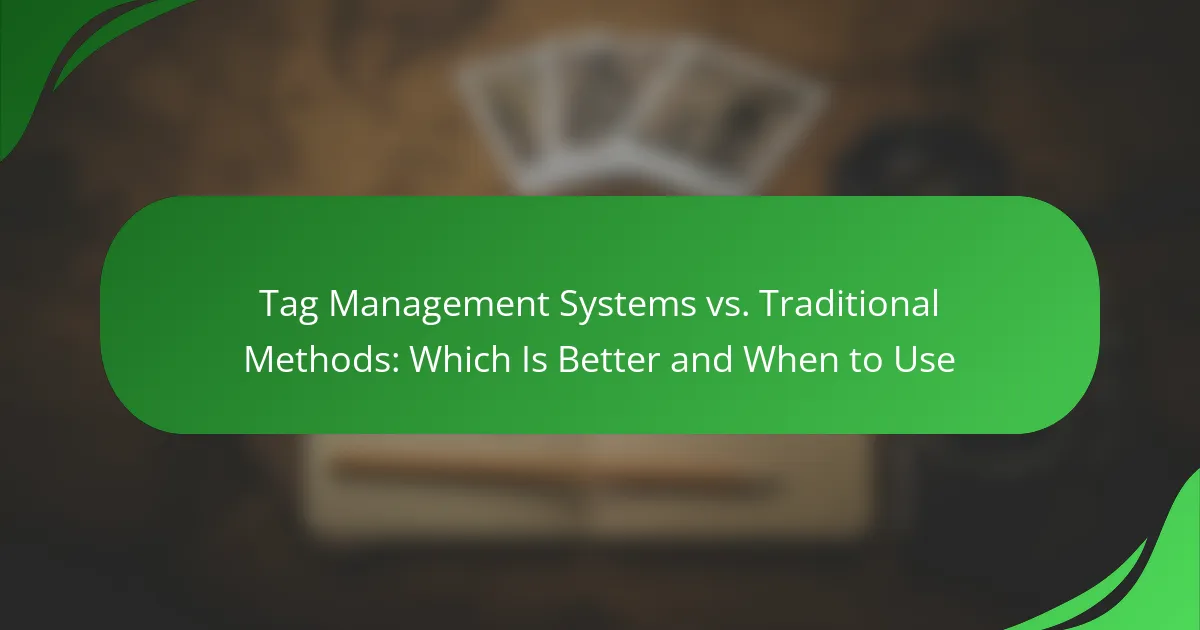In the evolving landscape of digital marketing, Tag Management Systems (TMS) offer significant advantages over traditional methods by providing streamlined tag deployment and centralized control. These systems are particularly beneficial for businesses that require frequent updates and integration of multiple marketing tools, allowing for improved data accuracy and enhanced campaign performance. However, potential limitations such as user learning curves and misconfigurations must be considered when deciding whether to implement a TMS.

What are the benefits of Tag Management Systems in Canada?
Tag Management Systems (TMS) provide several advantages for businesses in Canada, including streamlined deployment, centralized control over marketing tags, and improved data accuracy. These systems enable marketers to manage tags efficiently, reducing reliance on IT resources and enhancing overall campaign performance.
Improved deployment speed
Tag Management Systems significantly enhance deployment speed by allowing marketers to add or modify tags without needing extensive coding knowledge. This means that changes can be made in real-time, often within minutes, rather than waiting for IT teams to implement updates. As a result, businesses can respond quickly to market changes and optimize campaigns more effectively.
For example, a retailer running a seasonal promotion can quickly implement tracking tags to measure campaign performance, ensuring they capture relevant data without delays.
Centralized control
A TMS provides centralized control over all marketing tags, which simplifies management and reduces the risk of errors. Marketers can oversee all tags from a single interface, making it easier to ensure compliance with local regulations and data privacy standards, such as Canada’s Personal Information Protection and Electronic Documents Act (PIPEDA).
This centralized approach also allows for better collaboration among team members, as everyone can access the same data and insights, leading to more informed decision-making.
Enhanced data accuracy
With a Tag Management System, businesses can achieve enhanced data accuracy by minimizing the chances of human error during tag implementation. Automated processes ensure that tags are consistently deployed across all platforms, leading to more reliable data collection.
Accurate data is crucial for effective analytics and reporting, allowing companies to make data-driven decisions that can improve marketing strategies and customer engagement.
Cost-effective management
Implementing a Tag Management System can be a cost-effective solution for businesses in Canada. By reducing the need for extensive IT support and enabling marketing teams to manage tags independently, companies can save on operational costs. This efficiency allows for reallocating resources to other critical areas, such as strategy development and customer experience enhancements.
Additionally, many TMS options offer scalable pricing models, making it easier for businesses of various sizes to find a solution that fits their budget.

When should you use Tag Management Systems?
Tag Management Systems (TMS) are best utilized when you need to streamline the process of managing multiple tags on your website. They are particularly beneficial for businesses experiencing high traffic, requiring frequent updates, or integrating various marketing tools.
High website traffic
If your website attracts high traffic, a Tag Management System can significantly enhance performance. TMS allows for faster loading times by managing tags efficiently, reducing the need for multiple scripts that can slow down your site.
Consider implementing a TMS if your website receives thousands of visitors daily. This can help ensure that tracking and analytics tags do not hinder user experience, which is crucial for retaining visitors and improving conversion rates.
Frequent updates needed
For websites that require regular updates to tags, a Tag Management System offers a flexible solution. It allows marketers to make changes without needing to involve developers, streamlining the process and reducing time to implement updates.
Using a TMS, you can quickly add or modify tags in response to marketing campaigns or changes in strategy. This agility can be a game-changer, especially for businesses that need to adapt quickly to market conditions or consumer behavior.
Multiple marketing tools integration
When your marketing strategy involves various tools, a Tag Management System simplifies integration. TMS can centralize the management of tags from different platforms, ensuring that data flows seamlessly between them.
For example, if you use tools like Google Analytics, Facebook Pixel, and AdWords, a TMS can help you manage these tags in one place. This not only saves time but also minimizes the risk of errors that can occur when managing multiple tags manually.

What are the limitations of Tag Management Systems?
Tag Management Systems (TMS) have several limitations that can impact their effectiveness. While they streamline the process of managing tags, issues such as user learning curves and potential misconfigurations can hinder their performance.
Learning curve for users
Users may face a significant learning curve when adopting a Tag Management System. Understanding the interface, features, and best practices can take time, especially for those unfamiliar with digital marketing tools. Training sessions or comprehensive documentation can help mitigate this challenge.
It’s essential to allocate time for onboarding and practice. Consider starting with basic functionalities before moving on to more advanced features. This gradual approach can enhance user confidence and proficiency.
Potential for misconfiguration
Misconfiguration is a common risk associated with Tag Management Systems. Incorrectly set tags can lead to data inaccuracies, affecting analytics and marketing strategies. Regular audits and testing are crucial to ensure tags are functioning as intended.
To minimize misconfiguration, implement a checklist for tag setup and regularly review tag performance. Utilize version control features, if available, to track changes and revert to previous configurations if necessary. This proactive approach can help maintain data integrity and optimize system performance.

How do traditional methods compare to Tag Management Systems?
Traditional methods involve manual coding for tracking and analytics, while Tag Management Systems (TMS) automate these processes. TMS streamline tag deployment, making it easier to manage and update tracking codes without extensive coding knowledge.
Manual coding vs. automated tagging
Manual coding requires developers to write and implement tracking scripts directly into the website’s code. This process can be cumbersome and requires technical expertise, making it less accessible for marketers. In contrast, automated tagging through a TMS allows users to add, modify, or remove tags without altering the website’s code, significantly simplifying the management process.
For example, a TMS can allow marketers to deploy new tags in minutes, while manual coding might take hours or days, depending on the complexity of the updates needed.
Time-consuming updates
Updating tags manually can be a slow process, often requiring developers to revisit the code each time a change is needed. This can lead to delays in implementing new tracking requirements or adjustments based on campaign performance. A TMS enables quick updates across multiple tags from a single interface, reducing the time spent on these tasks.
Businesses can save significant time and resources by utilizing a TMS, allowing them to focus on strategy rather than technical implementation.
Higher risk of errors
Manual coding is prone to human error, which can result in broken tags or inaccurate data collection. These errors can lead to flawed analytics and misguided marketing decisions. A TMS minimizes this risk by providing a controlled environment for tag management, often including validation features to ensure tags are functioning correctly before deployment.
By reducing the likelihood of errors, a TMS helps maintain data integrity, which is crucial for effective decision-making in marketing strategies.

What factors to consider when choosing a Tag Management System?
When selecting a Tag Management System (TMS), consider integration capabilities, user interface, and support resources. These factors significantly influence how effectively a TMS can streamline your tagging processes and enhance data collection.
Integration capabilities
Integration capabilities refer to how well a TMS connects with existing tools and platforms. A robust TMS should seamlessly integrate with your website, analytics tools, and marketing platforms, allowing for efficient data sharing and management.
Look for systems that support popular platforms like Google Analytics, Facebook Pixel, and various CRM systems. A TMS with extensive integration options can save time and reduce the complexity of managing multiple tags across different services.
User interface and ease of use
The user interface of a TMS is crucial for ensuring that team members can easily navigate and utilize its features. A clean, intuitive design allows users to implement and manage tags without extensive training.
Consider systems that offer drag-and-drop functionality or visual tag management. This can significantly reduce the time needed to deploy tags and make it easier for non-technical users to contribute to tag management.
Support and documentation
Support and documentation are essential for troubleshooting and maximizing the use of a TMS. A system with comprehensive documentation, tutorials, and responsive customer support can help users resolve issues quickly and effectively.
Evaluate the availability of resources such as user forums, knowledge bases, and direct support channels. Good support can make a significant difference, especially during the initial setup and when implementing advanced features.

How to implement a Tag Management System in Canada?
Implementing a Tag Management System (TMS) in Canada involves selecting the right platform and configuring it to meet your specific tagging needs. A TMS simplifies the management of website tags, allowing for easier tracking and analytics without extensive coding.
Step 1: Define tagging needs
Start by assessing what data you need to collect and how it will be used. Identify key metrics, such as user interactions, conversions, and traffic sources. This clarity will guide your TMS configuration and ensure you capture relevant information.
Consider the types of tags required, such as analytics, marketing, or social media. Prioritize tags based on their importance to your business goals, which will help streamline the implementation process.
Step 2: Select a suitable platform
Choose a TMS that aligns with your defined tagging needs and integrates well with your existing tools. Popular options in Canada include Google Tag Manager, Adobe Tag Manager, and Tealium. Evaluate each platform based on features, ease of use, and pricing.
Look for platforms that offer strong support and community resources. This can be crucial for troubleshooting and maximizing the effectiveness of your tag management strategy.
Step 3: Configure tags and triggers
Once you’ve selected a platform, begin configuring your tags and triggers. Tags are snippets of code that collect data, while triggers determine when and where these tags fire. Set up your tags according to the needs identified in the first step.
Test each tag and trigger to ensure they work as intended. Utilize built-in debugging tools provided by your TMS to verify that data is being collected accurately and efficiently. Regularly review and update your tags to adapt to changing business needs or website updates.



